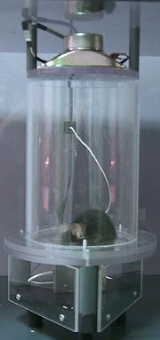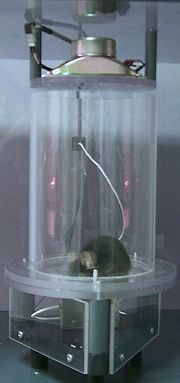
Startle reaction
Encyclopedia
The startle response is a brainstem reflex that serves to protect the back of the neck (whole-body startle), or the eye (eyeblink), and also facilitates escape from sudden stimuli. It is found across the lifespan and in many species. An individual's emotional state may lead to a variety of different responses. The Startle Response is also known as the Moro reflex
in younger children and is said the change around 3-6 months.
 The pathway for this response
The pathway for this response
was largely elucidated in rats in the 1980s.
In summary the basic pathway follows the auditory pathway from the ear up to the Nucleus of the Lateral Lemniscus
(LLN) from where it then activates a motor centre in the reticular formation. This centre sends descending projections to lower motor neurones of the limbs.
In slightly more detail this corresponds to: Ear (cochlea
)->Cranial Nerve VIII (auditory) -> Cochlear Nucleus (ventral/inferior) -> LLN -> Caudal pontine reticular nucleus
(PnC). The whole process has a less than 10ms latency. There is no involvement of the superior/rostral
or inferior/caudal
colliculus in the reaction that "twitches" the hindlimbs, but these may be important for adjustment of pinnae, gaze towards the direction of the sound or the associated blink.
Moro reflex
The Moro reflex, which is distinct from the startle reflex, is one of the infantile reflexes.It may be observed in incomplete form in premature birth after the 28th week of gestation, and is usually present in complete form by week 34...
in younger children and is said the change around 3-6 months.
Acoustic Startle Reflex

Stimulus (physiology)
In physiology, a stimulus is a detectable change in the internal or external environment. The ability of an organism or organ to respond to external stimuli is called sensitivity....
was largely elucidated in rats in the 1980s.
In summary the basic pathway follows the auditory pathway from the ear up to the Nucleus of the Lateral Lemniscus
Lateral lemniscus
The lateral lemniscus is a tract of axons in the brainstem that carries information about sound from the cochlear nucleus to various brainstem nuclei and ultimately the contralateral inferior colliculus of the midbrain...
(LLN) from where it then activates a motor centre in the reticular formation. This centre sends descending projections to lower motor neurones of the limbs.
In slightly more detail this corresponds to: Ear (cochlea
Cochlea
The cochlea is the auditory portion of the inner ear. It is a spiral-shaped cavity in the bony labyrinth, making 2.5 turns around its axis, the modiolus....
)->Cranial Nerve VIII (auditory) -> Cochlear Nucleus (ventral/inferior) -> LLN -> Caudal pontine reticular nucleus
Caudal pontine reticular nucleus
The caudal pontine reticular nucleus or nucleus reticularis pontis caudalis is composed of gigantocellular neurons.In rabbits and cats it is exclusively giant cells, however in humans there are normally sized cells as well....
(PnC). The whole process has a less than 10ms latency. There is no involvement of the superior/rostral
Superior colliculus
The optic tectum or simply tectum is a paired structure that forms a major component of the vertebrate midbrain. In mammals this structure is more commonly called the superior colliculus , but, even in mammals, the adjective tectal is commonly used. The tectum is a layered structure, with a...
or inferior/caudal
Inferior colliculus
The inferior colliculus is the principal midbrain nucleus of the auditory pathway and receives input from several more peripheral brainstem nuclei in the auditory pathway, as well as inputs from the auditory cortex...
colliculus in the reaction that "twitches" the hindlimbs, but these may be important for adjustment of pinnae, gaze towards the direction of the sound or the associated blink.
See also
- Prepulse inhibitionPrepulse inhibitionPrepulse Inhibition is a neurological phenomenon in which a weaker prestimulus inhibits the reaction of an organism to a subsequent strong startling stimulus . The stimuli are usually acoustic, but tactile stimuli Prepulse Inhibition (PPI) is a neurological phenomenon in which a weaker...
- attenuation of the startle response after a weaker preceding stimulus, or prepulse. - Surprise (emotion)Surprise (emotion)Surprise is a brief emotional state experienced as the result of an unexpected event. Surprise can have any valence; that is, it can be neutral/moderate, pleasant, or unpleasant. If a person experiences a very powerful or long lasting surprise, it may be considered shock.-Reality...

